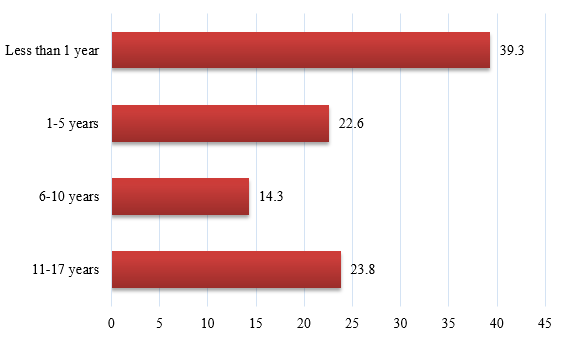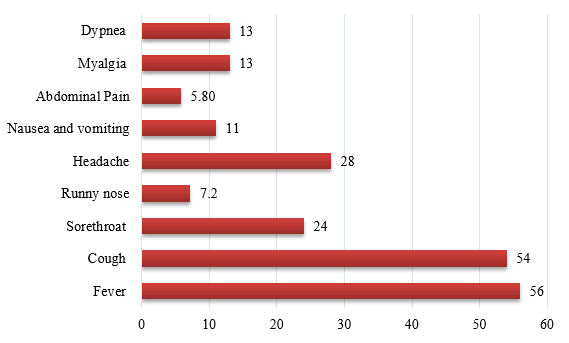Introduction
COVID- 19 pandemic or Coronavirus disease 2019, had threatened the whole world by causing catastrophic major public health crisis, and had affected hundreds of thousands of people worldwide, but data on how it affects children are rare.1, 2 Children have so far accounted for 0.39 -12.3% of affected disease population.3 As per the reports, in Wales, a 3-day old baby died after his mother tested positive with COVID & in Connecticut, a 6-week old infant died of complications related to the disease.4 In India, a 20-day old infant died of septicemia in Mumbai was the youngest death reported so far,5 and recently in May 2021, a 39-day old baby boy died in Kerala with COVID-19.6 Even though a large number of studies have reviewed symptoms and characteristics of adults with COVID-19, only some of them have included a smaller number of children.7 Transmission of disease can occur from direct inhalation of droplets, which are shed from the infected person through coughing or sneezing, as well as direct contact with surfaces and fomites soiled by infected respiratory secretions.8 The virus can survive on the contaminated surfaces for few hours to few days, which is comparatively lower at higher temperatures and low humidity conditions, with an average incubation period of 5-6 days.9, 10
Purpose of the Study
This study aimed a) To examine the epidemiological characteristics of SARS-CoV-2 infection reported in children from published studies b) To outline the signs and symptoms of SARS-CoV-2 infection reported in children from the research studies and c) To provide converging evidence of the clinical outcomes and prognosis of children affected with SARS-CoV-2 infection from reported studies.
Materials and Methods
A literature review was conducted through online sources of data base available in the Medline/Pub Med, Google Scholar, Science Direct & ProQuest. Studies published from Jan 2020 up to September 2021were included. Search terms include “Clinical features”, “COVID-19”, “Children”, “Epidemiological Characteristics”, “Prognosis”, “Signs and symptoms”, “Complications” etc.
Results
Causative organism
The Coronaviruses (CoVs) belong to a large family of Zoonotic RNA viruses, which appear as enveloped and single stranded viruses. The commonly infecting CoVs among humans are: HCoV2-229E, -HKU1, -NL63 and -OC43. The CoVs have the capability of rapid mutating ability and recombination, thus can lead to novel CoVs, and can spread from animals to humans. The novel CoVs which caused an outbreak among humans in severe acute respiratory syndrome (SARS-CoV) in 2002 and Middle East Respiratory syndrome corona virus (Mers-CoV) in 2012 first reported in China and Saudi Arabia respectively. The SARS-CoV-2, or COVID-19, is the novel corona virus first appeared in 2019 December in China, and thereafter in many other countries, had caused such a massive destruction to the lives of humans and currently causing the pandemic.11
Incubation period of SARS-CoV-2 infection in children
The average range of incubation period reported with SARS-CoV-2 infection is 5-7 days in children and 2-14 days in young adolescents. 12
Age and gender-wise distribution of children affected with COVID-19 infection
Children under 1 year of age had reported as the highly affected population with COVID-19, with 39.3% of the reported cases (Figure 1). 13 Male children showed a slightly higher predominance of affected population compared to girls, with 56.6% and 43.4% respectively. 14, 15
Transmission or exposure information
The major route of transmission in reported studies included the respiratory route, through droplets or droplet contaminated surfaces. Fecal-oral transmission is also reported, and especially a causative factor responsible for human spread of infection, with prolonged viral shedding reported even when the nasopharyngeal swab is tested negative for pediatric patients.16 In another study involving pediatric SARS-CoV-2 infection, all children had positive stool RT-PCR results after 10 days, without positive throat swabs, clinical symptoms or imaging findings.17 Rare or not reported routes of transmission are vertical transmission, cord blood, breast milk, nosocomial transmission, and ocular transmission.18, 19 The virus propagation occurs by means of community and intrafamilial spread, with family clusters being the commonest mode of spread of infection (90%). In familial spread, 76.6% of the spread occurs through confirmed family members and 13.5% occurs through suspected family members, whereas 8.8% and 1.2% of the infection spreads through unidentified source of infection and contact with other suspected cases respectively.18, 20
Clinical presentation and signs and symptoms
Majority of children brought to the hospital presented with respiratory symptoms (65%), with 51% presenting with mild form of the disease. Almost 39% of children presented with moderate symptoms, 5% with severe disease, 4% being asymptomatic and 1% with critical disease condition. 14, 21 The common signs and symptoms presented in children is given in Figure 2, and the data is highly variable in reported studies.22 Initial non-respiratory symptoms commonly reported in children included abdominal pain (4.4%), vomiting (6.4%), poor appetite (32.8%), and diarrhea (8.8%), whereas the percentages were not available for symptoms like raspberry jelly stools (with blood), convulsions, drowsiness, conjunctivitis/eyelid dermatitis, but these figures are highly variable.23
Common complications reported in children
In general, countries have reported that complications among pediatric population were rare, and had observed in children who presented with severe symptoms of SARS-CoV-2 infection, or occurred in those complicated with underlying disease conditions such as impaired lung function or immunosuppression or cardiac problems.24 (24) The common complications occurred involved acute renal failure, acute respiratory distress syndrome (ARDS), bacterial sepsis, encephalopathy, status epilepticus, multisystem inflammatory syndrome (MIS-C), septic shock, myocarditis, disseminated intravascular coagulation. Pneumonia etc.25
Protective factors for better prognosis in children
Preliminary evidence reported from research studies suggests a lower risk for severe forms of the disease and experience a mild disease for those who tested positive for COVID-19.11, 24, 26 The exact cause for these remains elusive, but could be related to many factors.11, 24 In general, the immune systems of children and adults are different, with regard to its composition and functional responsiveness, and that children can have a qualitatively different response to the SARS-CoV-2 virus compared to adults.27 Strong innate immune response can be attributed to have a protective effect in infants due to immune training,21, 24, 25, 26 which is secondary to live-vaccines and frequent viral infections. The presence of other viruses in the mucosa of lungs and airways of children is also thought to limit the growth of SARS-CoV-2 by direct virus-to virus interactions and competition.28 It is also recognized that the alveolar epithelial cells have a greater regenerative capacity in children.22 Moreover, children have a difference in the expression of angiotensin converting enzyme 2 receptor (ACE2), expressed in the airways, lungs and intestines, which is essential for the binding and infection of SARS-CoV-2. In adults, treatment with ACE inhibitors or angiotensin receptor blockers induces expression of ACE2, and leads to an elevated level, causing worse outcomes in adults infected with SARS-CoV-2. 24, 25, 29, 30 Children also has absence of risks like smoking, obesity, and comorbidities, which could also affect the way the disease is expressed in them, often limiting with a milder form of the disease. 1, 24
Limitations
The main limitation of this review article is the limitation in the empirical data collected from large-scale multicenter studies. Few of the studies in this review had reported with a small sample size and the data was obtained mainly from children who had been reported with symptoms, or have been laboratory tested. Also, there was a large variation in the data reported from time to time from various countries which made it difficult to present the findings.
Conclusion
Current findings indicate that children have a lower incidence of the disease, with a milder predominance. Most of the children recovered within 1-2 weeks after the onset of symptoms. Massive serological testing for SARS-CoV-2 will enable to more realistically assess the role of asymptomatic children in disease transmission. Prolonged shedding of virus in nasal and stool secretion has substantial implication for community spread in child-care centers, schools and homes.
Acknowledgements
I would like to sincerely thank Professor (Dr.) Usha Marath, Principal, Lisie College of Nursing, Professor Mrs. Manju George Pynadath, Department of Psychiatric Nursing, Lisie College of Nursing, and my former colleague Dr. Sumathi P.V., Associate Professor, Child Health Nursing Department, Lisie College of Nursing for giving me a whole-hearted support.


